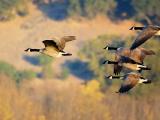Jul 8, 2004 (CIDRAP News) – In the face of new outbreaks, the World Health Organization (WHO) today expressed renewed concern about the implications of H5N1 avian influenza for human health and appealed for increased scrutiny of infections in animals and humans.
The latest outbreaks in China and Vietnam, along with two new research reports, suggest that the virus is more widespread and may be more difficult to eliminate than was previously thought, the WHO said. The agency said its laboratory network needs virus isolates and clinical specimens from all the recent outbreaks so it can better monitor the circulating strains.
As it has before, the WHO expressed concern that influenza A(H5N1) could acquire the ability to spread readily from person to person, which could lead to a global flu pandemic. In the widespread outbreaks in East Asia earlier this year, the virus jumped to humans, causing at least 34 cases and 23 deaths. But all the human patients apparently acquired the virus directly from birds.
In recent weeks, new outbreaks of avian flu have been reported in Vietnam, China, and Thailand. No new human cases have been reported, however. Chinese officials have said they confirmed the presence of H5N1 virus in their outbreak.
The WHO noted that a recent report by Chinese researchers indicates that the virus appears to be widespread in domestic ducks in southern China. The researchers also found that the virus has been causing increasingly severe disease, but that finding was based on tests in mice and may not have direct implications for humans, the WHO said. The article was published in the Proceedings of the National Academy of Sciences (see link below).
Another report, published this week in Nature, "indicates domestic and wild birds in the region may have contributed to the increasing spread of the virus and suggests that the virus is gaining a stronger foothold in the region," the WHO said. "These observations suggest that control of the virus may be even more difficult than thought in the spring."
The statement went on to say that known risk-management tools can control poultry outbreaks of H5N1 avian flu, though it may take months or years to control the virus completely. But the risk to human health is not well understood, and tools for assessing that risk are less developed, the agency said.
It is not clear why, after circulating in Asia for several years, the virus has not picked up the ability to infect humans easily, the WHO said. The agency called for, and offered to help with, urgent "risk assessment activities, including surveillance in animals and humans, and strain analysis."
"More knowledge of the virus could be acquired if WHO had full access to all virus isolates and clinical specimens from recent outbreaks," officials said. "All H5N1 viruses are not the same, and how they differ could provide important insights." For example, the avian flu virus in Indonesia differs slightly from those in Vietnam and Thailand, but the significance of the difference is unknown.
The WHO said it is continuing pandemic preparedness efforts that were launched during the avian flu outbreaks earlier this year. The agency is collaborating with scientists and the pharmaceutical industry to monitor changes in the virus's susceptibility to antiviral drugs. In addition, two US vaccine manufacturers have produced a supply of trial vaccine for pandemic flu. Samples from recent outbreaks would help the WHO assess the adequacy of the strain used in the pandemic vaccine, officials said.
The WHO also said:
- Governments should provide human flu vaccinations to workers who cull poultry to control outbreaks.
- Everyone exposed to infected birds should be provided with antivirals.
- Human trials of experimental pandemic flu vaccines should be accelerated.
See also:
Jul 8 WHO statement
http://www.who.int/csr/don/2004_07_08/en/
Abstract of study in the Proceedings of the National Academy of Sciences
http://www.pnas.org/cgi/content/abstract/0403212101v1?etoc




















